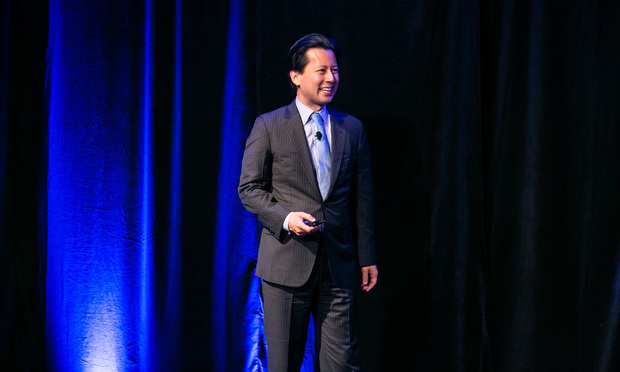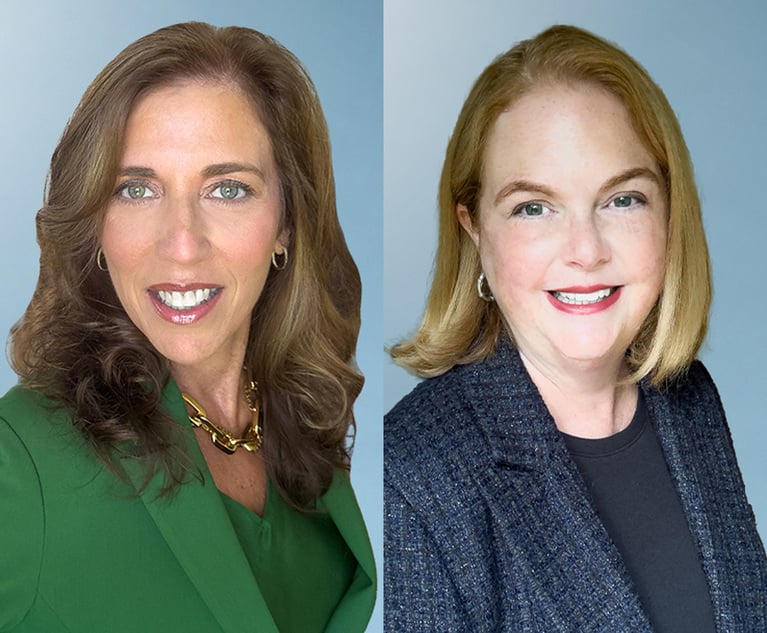Does 'Covering' Help Mask a Diverse Big Law Workplace?
At the recent DLA Piper Global Technology Summit in Silicon Valley, law professor Kenji Yoshino discussed the best ways to measure diversity and inclusion in the legal profession.
October 16, 2018 at 04:37 PM
7 minute read
 Kenji Yoshino at the DLA Piper Global Technology Summit (Photo: Barak Shrama/Orange Photography)
Kenji Yoshino at the DLA Piper Global Technology Summit (Photo: Barak Shrama/Orange Photography)
Diversity, an increasingly important issue in the Big Law realm, was a subject of discussion at the DLA Piper Global Technology Summit last week in Silicon Valley.
Kenji Yoshino, a prominent legal industry inclusion advocate and the Chief Justice Earl Warren Professor of Constitutional Law at New York University School of Law, is the author of ”Covering: The Hidden Assault on Our Civil Rights,” a book that looks at why some people choose to downplay or ”cover” aspects of their identity at work, which can affect their careers.
Those decisions masking identities based on age, citizenship, disability, gender, race, religion and sexual orientation are part of an effort, Yoshino said, to ”blend into the mainstream.” During the second day of DLA Piper's tech summit in Menlo Park, California, Yoshino shared findings based on his own research with a group of lawyers and entrepreneurs.
Yoshino was inspired to look into what he called a “second-generation form of bias in the workplace” by a law review article he once wrote that examined how an individual could win a discrimination case if they were fired for being a certain race, but not if they looked a certain way. During his talk at DLA Piper, he compared Big Law to Fortune 500 companies, noting that in terms of workplace diversity and inclusion, the legal world is not that much different from the business one.
Citing a 2013 report he conducted in conjunction with Deloitte, Yoshino said that among the more than 3,000 professionals studied, 61 percent of the respondents reported covering one or more of their identities. Yoshino's analysis found that 83 percent of lesbian, gay and bisexual individuals, 79 percent of African-Americans, 66 percent of women and 63 percent of Hispanics covered in some way to conform to mainstream corporate culture. The study also showed that 45 percent of straight white men reported covering parts of their identities.
Yoshino is now encouraging the legal community to create a culture and environment for people to be their “authentic” selves. He is working with such firms as DLA Piper on a number of diversity initiatives that seek to address that issue from the top-down. The Recorder caught up with Yoshino to further discuss diversity and inclusion in Big Law.
TR: How do law firms compare with the Fortune 500 when it comes to workplace diversity?
Yoshino: I think there are similarities and differences. Many of the issues confronting Big Law are also [present at] Fortune 500 companies, law schools and educational institutions. From work-life balance to gender [issues] and to my particular area of research, which has to do with “covering,” we found all three to be cross-cutting in our survey. I think what is different about Big Law is that I noticed a market-based idea of diversity and inclusion, which dates back to Montesquieu. His idea was that if you trade with other people, it forces you to empathize with those who are different from you. Because they are consumer-facing, they are trying to service a broad and diverse market, so the Fortune 500 has tended to be ahead of law firms.
I would put educational institutions behind law firms with regards to the attention they have put on diversity and inclusion. If you look at Fortune 500 companies, diversity and inclusion were well under the radar a couple of decades ago. It is only now that we are seeing universities, for example, appoint chief diversity or inclusion officers. Fortune 500 companies are closer to the market and consumers, while law firms are more isolated because they are business-to-business, they are serving those companies. Law schools are perhaps the most isolated from the market because we are not accountable to market pressure.
What is actually changing in the legal world when it comes to diversity in the workplace?
The change that I have seen is that Fortune 500 companies are now turning to Big Law and saying, 'If you don't send us a diverse team, then we are going to penalize you.' [Hewlett-Packard and its] general counsel Kim Rivera issued a statement saying they are going to have a 10 percent clawback for law firms that do not meet their diversity metric. Now firms are turning to law schools, like my own, and asking what we're doing about diversity issues and creating the pipeline [of students] they need to service clients.
Is there “covering” in Big Law?
I don't recall large differences [between law firms and the Fortune 500]. Others have noted that law is among the more conservative professions. I am thinking about Lauren Rivera's work at the Kellogg School of Management at Northwestern University. She said that when she looks at investment banks, consulting firms and some law firms, [the latter] seem to be most concerned with what she calls “pedigree,” which more broadly is the notion that you have to fit into a certain mold in order to work in an environment. There are certain scholarships that support the theory that law is a particularly conservative, sort-of buttoned-down profession. To my recollection, we have not seen that in our survey results comparing law firms to the Fortune 500.
What are some misconceptions about diversity and inclusion in Big Law? Are law firm diversity scores a good metric?
I think they are important, but I would like to see [diversity scores] be fine-tuned. What we are trying to do in thinking about “covering” is to focus on the inclusion piece of the puzzle. And to say no matter how diverse you are as in terms of your demographic numbers, it is unlikely those numbers are going to stay steady unless you have an inclusive environment. One of the things that many firms are struggling with is that their incoming [associate classes] are quite diverse, but then there is a fall off with regard to number of individuals who remain in a firm over time, in part, because even though you have diversity at the entry level, you don't have inclusion across the life of the lawyers in question.
Law school became 50/50 between men and women around 2001. And the last round of statistics in Big Law, 19.5 percent of equity partners were women, but 10 years ago that number was 16 percent. So we have only seen a 3.5 percent[age point] increase over 10 years, which by my calculation means that we will reach parity between men and women in 2107! I think that we need a different hypothesis and a different metric than simply looking at the diversity numbers year over year. I think we need other indexes that look at how inclusive an environment is, how comfortable people are being themselves and how much they feel a firm's culture will accommodate them. That is really what the covering project is all about, how much you feel like you have to bend yourself out of shape in order to be respected in the workplace.
How do we know if firms are doing a good job?
I think for a long time we have struggled with how to measure the degree of inclusiveness in an environment. I'm not saying that covering is the only solution, but I do feel like it is an important answer to the question of how we measure inclusion. What my study with Deloitte suggested is that even if all the organizations we surveyed did have a strong position on inclusion, as well as diversity based on race and ethnicity or sexual orientation, that is not the lived experience of people within the organization. Beyond marking down how many gay, female or black attorneys we have, examine how those lawyers feel like they need to manage their identities in ways that impinge on their sense of self and their well-being in the workplace. That is our contribution to this debate. This is a not a problem for the law to solve, but one for organizations and institutions to solve on their own.
All interviews are condensed and edited for style, clarity and grammar.
This content has been archived. It is available through our partners, LexisNexis® and Bloomberg Law.
To view this content, please continue to their sites.
Not a Lexis Subscriber?
Subscribe Now
Not a Bloomberg Law Subscriber?
Subscribe Now
NOT FOR REPRINT
© 2025 ALM Global, LLC, All Rights Reserved. Request academic re-use from www.copyright.com. All other uses, submit a request to [email protected]. For more information visit Asset & Logo Licensing.
You Might Like
View All
Once the LA Fires Are Extinguished, Expect the Litigation to Unfold for Years
5 minute read

Faegre Drinker Adds Three Former Federal Prosecutors From Greenberg Traurig
4 minute read
Anapol Weiss Acquires Boutique Led by Star Litigator Alexandra Walsh
5 minute readTrending Stories
- 1We the People?
- 2New York-Based Skadden Team Joins White & Case Group in Mexico City for Citigroup Demerger
- 3No Two Wildfires Alike: Lawyers Take Different Legal Strategies in California
- 4Poop-Themed Dog Toy OK as Parody, but Still Tarnished Jack Daniel’s Brand, Court Says
- 5Meet the New President of NY's Association of Trial Court Jurists
Who Got The Work
J. Brugh Lower of Gibbons has entered an appearance for industrial equipment supplier Devco Corporation in a pending trademark infringement lawsuit. The suit, accusing the defendant of selling knock-off Graco products, was filed Dec. 18 in New Jersey District Court by Rivkin Radler on behalf of Graco Inc. and Graco Minnesota. The case, assigned to U.S. District Judge Zahid N. Quraishi, is 3:24-cv-11294, Graco Inc. et al v. Devco Corporation.
Who Got The Work
Rebecca Maller-Stein and Kent A. Yalowitz of Arnold & Porter Kaye Scholer have entered their appearances for Hanaco Venture Capital and its executives, Lior Prosor and David Frankel, in a pending securities lawsuit. The action, filed on Dec. 24 in New York Southern District Court by Zell, Aron & Co. on behalf of Goldeneye Advisors, accuses the defendants of negligently and fraudulently managing the plaintiff's $1 million investment. The case, assigned to U.S. District Judge Vernon S. Broderick, is 1:24-cv-09918, Goldeneye Advisors, LLC v. Hanaco Venture Capital, Ltd. et al.
Who Got The Work
Attorneys from A&O Shearman has stepped in as defense counsel for Toronto-Dominion Bank and other defendants in a pending securities class action. The suit, filed Dec. 11 in New York Southern District Court by Bleichmar Fonti & Auld, accuses the defendants of concealing the bank's 'pervasive' deficiencies in regards to its compliance with the Bank Secrecy Act and the quality of its anti-money laundering controls. The case, assigned to U.S. District Judge Arun Subramanian, is 1:24-cv-09445, Gonzalez v. The Toronto-Dominion Bank et al.
Who Got The Work
Crown Castle International, a Pennsylvania company providing shared communications infrastructure, has turned to Luke D. Wolf of Gordon Rees Scully Mansukhani to fend off a pending breach-of-contract lawsuit. The court action, filed Nov. 25 in Michigan Eastern District Court by Hooper Hathaway PC on behalf of The Town Residences LLC, accuses Crown Castle of failing to transfer approximately $30,000 in utility payments from T-Mobile in breach of a roof-top lease and assignment agreement. The case, assigned to U.S. District Judge Susan K. Declercq, is 2:24-cv-13131, The Town Residences LLC v. T-Mobile US, Inc. et al.
Who Got The Work
Wilfred P. Coronato and Daniel M. Schwartz of McCarter & English have stepped in as defense counsel to Electrolux Home Products Inc. in a pending product liability lawsuit. The court action, filed Nov. 26 in New York Eastern District Court by Poulos Lopiccolo PC and Nagel Rice LLP on behalf of David Stern, alleges that the defendant's refrigerators’ drawers and shelving repeatedly break and fall apart within months after purchase. The case, assigned to U.S. District Judge Joan M. Azrack, is 2:24-cv-08204, Stern v. Electrolux Home Products, Inc.
Featured Firms
Law Offices of Gary Martin Hays & Associates, P.C.
(470) 294-1674
Law Offices of Mark E. Salomone
(857) 444-6468
Smith & Hassler
(713) 739-1250






